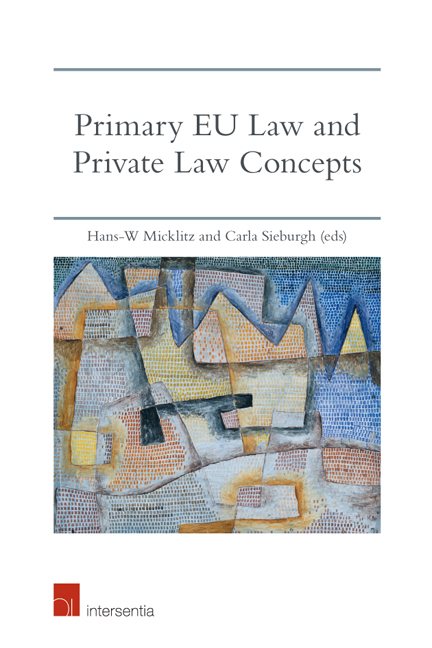Book contents
- Frontmatter
- Preface
- Summaries of the Chapters
- Contents
- Table of Cases: Alphabetical
- Table of Cases: Chronological
- List of Authors
- Chapter 1 Primary EU Law and Private Law Concepts
- Chapter 2 The Impact of Free Movement of Goods and Services on Private Law Rights and Remedies
- Chapter 3 The Impact of Free Movement of Capital on Private Law
- Chapter 4 The Impact of Competition Law on the Private Law Concepts of Nullity and Damages
- Chapter 5 The Impact of Article 101(2) TFEU Nullity on Private Law
- Chapter 6 The Impact of EU State Aid Law on National Private Law
- Chapter 7 The Impact of EU Intellectual Property Law and the Charter on Private Law Concepts
- Index
Preface
Published online by Cambridge University Press: 27 September 2018
- Frontmatter
- Preface
- Summaries of the Chapters
- Contents
- Table of Cases: Alphabetical
- Table of Cases: Chronological
- List of Authors
- Chapter 1 Primary EU Law and Private Law Concepts
- Chapter 2 The Impact of Free Movement of Goods and Services on Private Law Rights and Remedies
- Chapter 3 The Impact of Free Movement of Capital on Private Law
- Chapter 4 The Impact of Competition Law on the Private Law Concepts of Nullity and Damages
- Chapter 5 The Impact of Article 101(2) TFEU Nullity on Private Law
- Chapter 6 The Impact of EU State Aid Law on National Private Law
- Chapter 7 The Impact of EU Intellectual Property Law and the Charter on Private Law Concepts
- Index
Summary
The EC Treaty, so the European Court of Justice found in its judgment in Costa v ENEL, created its own legal order which has been integrated into the legal systems of the Member States and which their courts are bound to apply. This legal system is binding on both the Member States and their citizens. In Van Gend en Loos the Court of Justice expressly took the ground that EU law can have direct effect. Independently of the legislation of Member States it not only imposes obligations on individuals but is also intended to confer upon them rights which become part of their legal heritage. These rights arise not only where they are expressly granted by the Treaty, but also by reason of obligations which the Treaty imposes in a clearly defined way on individuals as well as upon the Member States and upon the institutions of the Community. In subsequent judgments the Court made it clear that this includes rights and obligations of a private law nature.
This volume has for its theme the interplay and influence exerted on approaches and legal concepts of private law, including property rights law, by primary EU law, particularly internal market law. The starting hypothesis is that the Court of Justice (also, the Court) has developed concepts in private law cases which are different in substance from the concepts which exist in the private law systems of the Member States. The project aims to present developments in current law of which EU lawyers and private lawyers generally are unaware. This book offers ground-breaking analyses of the main private law concepts (the person, property, contract and tort, and remedies) as they are used, created or adjusted by the Court. Each analysis results from insights obtained into the substantive meaning of the concepts deployed in the Court's case law, disconnected from national meanings of such concepts. The direction of this analysis is from the cases to the concepts, not the other way around: the cases and the facts behind the cases are the starting point. In this ways the analyses aim to avoid preconceptions based on national private law systems.
- Type
- Chapter
- Information
- Primary EU Law and Private Law Concepts , pp. v - viPublisher: IntersentiaPrint publication year: 2017



